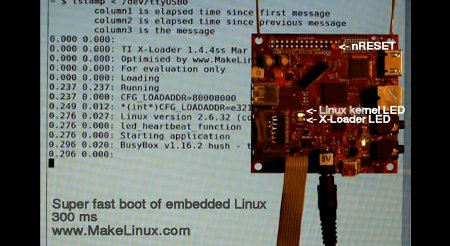A 300ms BeagleBoard boot?
Apr 12, 2011 — by Eric Brown — from the LinuxDevices Archive — 13 viewsMake Linux Software posted a video showing the “fastest ever embedded Linux boot.” The video shows a BeagleBoard equipped with a 720MHz TI OMAP3530 processor booting Linux 2.6.32 in an impressive 300 milliseconds from boot loader to shell — although the jury is out on just how useful the stripped-down 1.5MB image might be.
According to Make Linux Software — which is led and possibly comprised entirely of one Constantine Shulyupin — the "Super Fast Boot" project's initial goal is to achieve a "minimal boot time of a minimal but functional Linux system on common hardware." The second goal is to develop a boot platform for creating more functional systems "with an even minimized boot time," says the company.
 For its experiment, Make Linux Software used the original, open platform BeagleBoard. The Digi-Key distributed board (pictured) clocks its Cortex-A8-based Texas Instruments OMAP3530 system-on-chip (SoC) to 720MHz.
For its experiment, Make Linux Software used the original, open platform BeagleBoard. The Digi-Key distributed board (pictured) clocks its Cortex-A8-based Texas Instruments OMAP3530 system-on-chip (SoC) to 720MHz.
The software consists of a Linux 2.6.32 kernel from DVSDK 3.01, in a minimal configuration featuring a roughly 900KB footprint. The boot loader comprises an optimized x-loader, without U-boot, says the company. The software is said to use a statically compiled BusyBox v1.16.2 humble shell, sized at 600KB, adding up to 1.5MB.
Booting from NAND flash, the clocks starts from the launch of the boot loader, with the 300ms time recorded at the arrival of the shell. Presumably, however, it would take longer to get to an actual function such as taking a photo with a digital camera.

Final screen from Make Linux Software 300ms boot demo video
(Click to enlarge)
- logging starts at 70 ms from reset. Boot time from reset is 300 + 70 = 370ms.
- logging starts at 330 ms from power on. Cold boot time is 330 + 300 = 630ms.
- loading of 1.5 MB Linux image from NAND takes 237ms with throughput at 6MB/sec.
- code execution takes 60ms or 43M CPU cycles. (For other CPUs, frequency execution time is different, but number of processor cycles is the same.)
- the most time consuming operation is copying firmware from NAND flash.
On LWN.net's forums, "Jengelh" throws some cold water on the benchmark by noting that between the aging 2.6.32 kernel and stripped down 1.5MB version used, the resulting image is "hardly usable for any serious task." A "Giraffedata," meanwhile, adds that it would be more representative if the benchmark would include the portion of the boot process involved with "getting the system up to the boot loader."
Despite these caveats, Girafffedata writes that it is "still a highly useful benchmark, because it covers the common part of all these possible systems, and a part which has traditionally taken much longer."
Make Linux Software 300ms fast boot demo on YouTube
Source: Make Linux Software
(Click to play)
Make Linux Software says that binary images of the fast boot are available for evaluation. More information may be found at Make Linux Software's website.
This article was originally published on LinuxDevices.com and has been donated to the open source community by QuinStreet Inc. Please visit LinuxToday.com for up-to-date news and articles about Linux and open source.